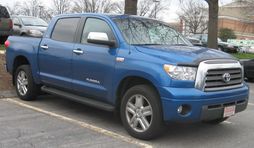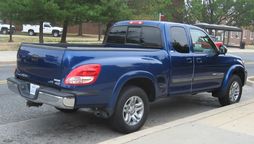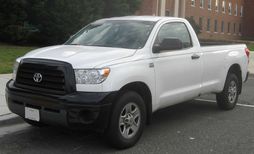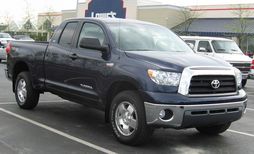The History Of Toyota Tundra

The Toyota Tundra is a full-size pickup truck sold by Toyota that originally went into production in 1999 (as a 2000 year model). The Truck was built with an American look and feel and ultimately had something the T100 never had, a V8 engine underneath its hood. The Tundra was nominated for the North American Truck of the Year award and was Motor Trend magazine's Truck of the Year in 2000 and 2008. As of 2007, the Tundra (now in its second generation) holds 17% of the 1/ 2 ton full-size pickup market beating the GMC Sierra in monthly sales, but still behind the Ford F-150. The newest Tundra is assembled in San Antonio, Texas, and Princeton, Indiana (where the original Tundra was solely constructed).
The first generation Tundra had many similarities with the old Toyota T100 and the smaller, more popular Toyota Tacoma. The biggest of those similarities was the use of the 3.4 liter V6 engine which was the top of the line engine in both the Tacoma and T100, while it became the base engine within the Tundra. However, the new Tundra has an optional 32-valve 5.7L V8 engine which ultimately is the most desired choice, as well as a 10,000lb (4,500kg) towing capacity.
Publicly introduced in May 1999 as a 2000 model, the Tundra prototypes and "show trucks" were initially known as T150s. However, Ford and automotive pundits felt that this name was too close to the market-leader Ford F-150, and following a lawsuit by Ford, the production truck was renamed the Tundra (Toyota claimed they never truly intended to use the T150 name in actual production). Toyota then countersued Ford regarding the name of their then-released Lincoln LS sedan, arguing it was too close to that of the Lexus LS.
The Tundra was slightly larger than the T100, but still suffered the perception of being too small and carlike to pose a serious threat to the domestic pickup trucks. With a production capacity of 120,000, sales were double the rate of the T100. The Tundra also had the largest initial vehicle sales for Toyota in its history (up until that time). It garnered impressive honors, including Motor Trend's Truck of the Year award for 2000 and Best Full- Size Truck from Consumer Reports. Built in a new Toyota plant in Princeton, Indiana, with 65 percent domestic content, the Tundra showed that Toyota was serious about closing the gap on the Big Three.
Engine choices available in the Tundra were a 24V 3.4 liter V6 engine that produced 190horsepower (140kW) and 220 lb·ft (298 N·m) of torque and a 32 valve 4.7 liter V8 engine that produced 245horsepower (183kW) and 315 lb·ft (427 N·m) of torque. A Toyota Racing Development (TRD) derived supercharger was already available for the 3.4 liter V6 that bumped horsepower to the 260horsepower (190kW) range and 260 lb·ft (353 N·m) of torque range, but TRD introduced a supercharger for the V8 engine late into its second year of production that pushed the V8 numbers to the mid 300horsepower (220kW) range and torque to the 400 lb·ft (550 N·m) range. Although the V6 supercharger is still widely available, the V8 supercharger is rarer and harder to find because of TRD stopping production of the device because of issues of its compatibility with the engine.
The grille was updated for 2003 and the Double Cab version was added to the lineup in 2004. The Double Cab model was a true crew cab with four normal doors, with interior and exterior details copied from the Toyota Sequoia. Its bed is nearly 5inches (130mm) longer than the competing Nissan Titan or Ford F-150. It is also 13inches (330mm) longer and 3inches (76mm) taller than the Regular and Access cab versions. A new engine was introduced in 2005: a 4.0 liter V6 rated at 236horsepower (176kW) and 266ft·lbf (361N·m) of torque, and the existing 4.7 liter V8 was updated with Toyota's VVT-i variable valve timing technology and was rated at 271horsepower (202kW) and 313ft·lbf (424N·m) of torque. The 5-speed manual gave way to a 6-speed manual, and a 5-speed automatic replaced the 4-speed. With a towing capacity of just 6,800 lb (on the Double Cabs) and a 7,100 pounds towing capacity on the Access Cabs and Regular Cabs with a V8 engine, it still did not have enough muscle to compete with the heavy-duty offerings of the Big Three and Nissan. Domestic truck aficionados still derided it as a "7/ 8 scale" pickup.[citation needed]
A larger Tundra was introduced at the 2006 Chicago Auto Show. It had lifted cues of its smaller brother the Toyota Tacoma along with some cues from the Toyota FTX concept truck. The truck had many enhancements, such as a towing capacity of up to 10,000+ lb, a payload capacity of over 2,000lb (910kg), and a new 6-speed automatic transmission. The second generation Tundra has 3 engines available. A new 5.7 liter V8 that produces 381horsepower (284kW) and 401pound-feet (544N·m) of torque, a 4.7 liter V8 rated at 276horsepower (206kW) and 313pound-feet (424N·m) of torque, and a recently introduced 4.0 liter V6 rated at 236horsepower (176kW) and 266pound-feet (361N·m) of torque.
When the new Tundra first came out in February 2007 it was available in 31 configurations, which consisted of 3 bed lengths, 3 cab configurations, 4 wheel-bases, and 2 transmissions The new Double Cab replaces the previous generations Access Cab, and the all new Crew Max replaces the previous generations Double Cab, it is also built to compete with the Dodge Ram Mega Cab. The Double Cab is available with a 6 and a half foot bed, regular bed, or an 8-foot (2.4m) long bed, while the Crew Max is only available with a 5 and a half foot short bed. The Tundra also features a new 6-speed automatic transmission with a manual shift mode which is standard with the 5.7 liter, and gives it a 0-60 time of 6.3 seconds, and a quarter mile time of 14.7 seconds. The 5.7 liter is a VVT-i (Variable Valve Timing with intelligence) engine, which is built to deliver power and fuel economy. The Tundra 5.7 liter 4x2's are rated to deliver an estimated 20miles (32km) to the gallon on the highway.
Toyota made the new Tundra useful for many construction workers, by including extra large door handles, deck rail system, integrated tow hitch, and headrests that can fit a worker with his hard hat on. The Tundra also includes as standard: an automatic limited slip differential (Auto LSD), vehicle stability control (VSC), traction control, electronic brake-force distribution (EBD), brake assist (BA), anti-lock brakes (ABS) and tailgate assist. However, its high starting MSRP of $22,290 makes it more expensive than the Chevy Silverado Work Truck (MSRP $17,860) and the base Ford F-150 (MSRP $17,345).
Some other changes Toyota included in the new Tundra are optional tow mirrors, a 27USgal (102L; 22imp gal) fuel tank, available 22 inch alloy wheels, backup camera, Bluetooth, large center console (big enough to fit a 15 inch laptop), extra-large disc brakes, and the aforementioned 6-speed sequential automatic transmission.
The all new Tundra is assembled in two different locations, both inside the United States; Princeton, Indiana and San Antonio, Texas. Toyota Motor Company will assemble around 150,000 Standard and Double Cabs, and only 70,000 Crew Max's in 2007.
The 2008 model added 13 variations bringing the total to 44 model variants. The 2008 models feature additional standard features at a lower price, also include a new "Tundra Grade" trim which is lower that the SR5 trim, and geared toward trades people and the price conscious consumer.
Toyota has made E85 fuel capability standard to 2009 Tundra's equipped with the 5.7L V8 in select regions. Toyota has also updated the TRD Sport package and added a TRD Rock Warrior package. Prices will increase 0.4% over the previous 2008 model year.
Safety
Toyota's Tundra was the first full-size pickup to have earned the Insurance Institute for Highway Safety's Top Safety Pick, followed by the redesigned 2009 Ford F-150. To receive this award the Tundra achieved an overall Good score in the frontal offset crash test, the highest possible rating in the side impact collision test, as well as a perfect score for rear crash protection, and standard electronic stability control.
The NHTSA gives the Tundra a four out of five-star frontal crash test rating for both the front driver and passenger. A four-star rating is given to vehicles when there is an 11% to 20% chance of serious injury, while a five star rating is given when there is 10% or less chance of serious injury.
The primary difference between IIHS and NHTSA frontal crash testing protocol is the IIHS conducts an offset collision where a smaller portion of the vehicle's structure absorbs the energy of the crash. According to the NHTSA offset tests are more demanding. Both IIHS and NHTSA frontal impact tests can only be compared among vehicles of similar weights.
Because the Tundra's stability control is disabled when the vehicle's 4x4 system is engaged Consumer Reports has questioned the Tundra's Top Safety Pick. Toyota's response is the Tundra does not feature a center differential which would otherwise serve as a weak point in the drive train. However the stability control system remains operational at times when the truck is in 4x2 mode.
Standard safety features include dual side airbags for both front seats. This includes side curtain airbags for head protection in both front and rear rows and torso airbags for the abdomen region in the front row. The torso type side airbag is a unique feature and unavailable on many competing pickup designs.
TRD supercharger
Toyota began selling a bolt-on supercharger kit for the 5.7L V8 Tundra during June 2008. Power output is increased to 504hp (376kW) and 550pound-feet (750N·m). When the install is carried out by a Toyota dealership the existing warranty remains intact. This kit features Eaton's Twin Vortices Series supercharger which utilizes twin four-lobe rotors, a design shared with the newly introduced C6 ZR1 and CTS-V.
MSRP for the kit is set at $5,875.
Edmunds tested a TRD supercharged Tundra which completed the 1/ 4 mile in 13.3 sec @ 103.8 mph. Edmunds previously tested a naturally aspired 5.7L V8 Tundras which posted 14.8 sec @ 93.7mph time.
Motor Trend's test of the supercharged Tundra resulted in a 1/ 4 mile of 13.0 sec @ 106.3 mph. This Tundra needed 4.4 seconds to run from 0-60mph.
Special editions
In June 2008 Toyota introduced the Ivan "Ironman" Stewart Signature Series Tundra. Three different packages are offered, one of which includes the TRD Supercharger.
Stewart has won the Baja 500 seventeen times driving Toyota vehicles.
Comparison testing
- Consumer Reports rates the Tundra as the 2nd best full-size pickup behind the Chevy Avalanche.
It should be noted the Chevy Avalanche is technically an SUT or an SUV with a truck bed. The Avalanche's rear suspension features coil springs unlike traditional leaf-springs.
- Canadian Driver crowns the Tundra as Truck King, selecting it as the best 1/ 2-ton pickup with an engine displacing greater than 5.0 Liters, and again as best 1/ 2-ton with an engine less than 5.0 Liters.
- Trailer Boats awards the Tundra with its 2007 Tow Vehicle of the Year award after completing nearly two weeks of testing.
- Motor Trend declared the Tundra its 2008 Truck of the Year (TOTY) winner. Other competitors tested were the Chevrolet Silverado HD, GMC Sierra HD, and Ford F-250, F-350 and F-450. While the Silverado, Motor Trend's 2007 TOTY was not in the competition, it defeated the Tundra in an earlier MT comparison as noted below.
- Motor Trend performed a Head to Head test in April 2007 with the 2007 Chevrolet Silverado and the 2007 Toyota Tundra. The Silverado was declared the winner.
- Truck Trend (Motor Trend) magazine rates the Tundra ahead of its GM competitor in a three round battle. This comparison occurred before the Tundra was officially on sale to the public.
1st Round 2nd Round Final Round
- Edmunds.com places the Tundra 1st in their 1/ 2-ton comparison test.
- Truckin' magazine awards the Tundra Crew Max with its 2008 Truck of the Year award.
- Peterson's 4-wheel & Off Road magazine gave the Tundra a 2nd place finish in their 2008 4x4 of the Year competition. First place went to the Toyota Landcruiser
- Popular Mechanics ranks the Tundra 2nd behind the Titan in a full size pickup comparison.
- In an April 2007 Comparo, Car and Driver placed the Tundra 3rd in a 5-truck roundup, behind the Nissan Titan and the Chevy Silverado.
2007 model year recalls
In May 2007, a Toyota spokesperson stated 20 camshaft failures occurred in Toyota's all-new 5.7L V-8 engine. Toyota said this was the result of a flaw in the camshaft casting process, and the supplier of the camshafts has since fixed the error. In the event of a camshaft failure Toyota will either replace the engines and extend the warranty or repurchase the truck from the owner. Toyota originally meant to begin selling the 5.7L V8 equipped Tundra during the summer of 2007 but decided to rush the engine into production in order to meet the February 2007 launch. This decision was made as a result of product planners and dealers seeking the larger V8's availability at the initial launch. The 5.7 V8 belongs to the Toyota UR engine family and carries the designation 3UR-FE.
On December 13, 2007, Toyota Motor Corp recalled 15,600 4x4 2007 model-year Tundras in the United States because a rear propeller shaft joint may fail. "There is a possibility that a joint in the rear propeller shaft may have been improperly heat treated, resulting in insufficient hardness," Toyota said. Adding, "This may cause a section of the rear propeller shaft to separate at the joint." There has been one reported case of abnormal noises in the affected vehicles. No accidents have been connected to the recall. Tundra owners will be notified beginning in late-December 2007 and are requested to contact their local Toyota dealer for inspection. If the hardness is not correct the dealer will then replace the rear propeller shaft.
In Consumer Reports' 2007 survey, the 4x4 Tundra had a below-average reliability rating due mainly to problems with the four-wheel-drive system. However, as of November 10th, 2008, Consumer Reports' 2008 survey showed that Toyota in general has apparently solved the problems. Now, the Tundra has an average reliability rating and the 4x4 Tundra is recommended.
Diesel Tundra
During September 2007 Toyota Motor Corporation announced plans to add a diesel variant of the Tundra. This was confirmed in January at the 2008 North American International Auto Show. There Toyota President Watanabe stated, "I am happy to confirm that a new clean-diesel V8 engine will be offered in both the Tundra and the Sequoia in the near future."
There is plenty of speculation as to what role the new Diesel Tundra will fill. Motor Trend and Car and Driver, have reported Toyota will produce a heavy-duty version of the Tundra designed to compete in the 3/ 4-ton class.
However, this latest news strongly indicates the Tundra's diesel engine will become an additional powertrain offering for the current 1/ 2-ton Tundra needed to compete with other light-duty truck diesel offerings soon planned by Ford, GM, Chrysler, and Nissan. . Still, Toyota could offer both 1/ 2-ton and new 3/ 4-ton diesels.
At the 2007 SEMA auto show, Toyota showcased its Tundra Diesel Dually Project Truck. This heavy-duty Tundra Diesel is based on a heavily modified Tundra Crew Max chassis. It features 8.0L Hino diesel engine, Eaton manual transmission, along with an extensive list of other modifications. High-resolution images are available in autoblog's gallery.
During late-2006 Toyota purchased a stake of Isuzu from General Motors. Isuzu Duramax V8 engine design currently powers GM's 3/ 4ton and 1-ton pickups and will also fulfill GM's future 1/ 2-ton diesel needs.
The Australian version of the Toyota Land Cruiser features a 4.5L diesel which the Tundra Diesel may be based on.
Considering Toyota's relationship with world-renowned diesel manufacturers Isuzu and Hino (Toyota owns portions of both), as of Feb. 2008 it's still anyone's guess as to the size or origin of the Tundra's new diesel engine.
Hybrid Tundra
Toyota President Katsuaki Watanabe has stated that he would like to develop a hybrid electric version of the Tundra. However, Toyota faces several technical challenges that it must overcome before it could bring such a vehicle to market.
According to the Japanese newspaper Nihon Keizai Shimbun, Toyota is considering developing a gasoline electric hybrid Tundra, for sale in North America around 2010..
Toyota may also introduce a diesel electric hybrid system for the Tundra. In Japan, the Toyota Dyna and Hino Dutro light trucks produced by the Toyota Motor use diesel electric hybrid systems. The Hino Ranger a medium to heavy duty cab-over truck could also provide hybrid technology for the next generation Tundra.
At the 2008 North American International Auto Show, Toyota USA President Jim Lentz stated "different models require different types of fuel saving technology…there may be a few [models] where hybrid technology doesn’t make sense". He further went on to say that the Tundra and the new Sequoia will not be offered with a hybrid engine in the near future, instead those vehicles would feature "clean, fuel efficient diesel engines. For now, it seems, the Tundra Hybrid has been sent back to the drawing board or cancelled entirely.
GM is offering the Silverado and Sierra with hybrid powertrains for the 2009 model year. Batteries are sourced from Panasonic which Toyota also uses for their hybrids powertrains.
The Toyota Tundra has sold at or just under its production capacity since 2000. The Indiana factory can produce 130,000 Tundras a year. The Tundra has been on the market for more than half a decade, and has captured 17 percent of the full-size half-ton market. In the year 2000 Toyota sold 107,798 Tundras, which was a huge step forward from the Toyota T100 pickup which sold roughly around 50,000 units. By 2005 Toyota Motor Corporation managed to sell 126,529 Tundras. The best selling Ford F-150 sold 756,980 units that same year. With the added capacity of the San Antonio plant, Toyota planned to sell around 200,000 Tundras for 2007. Toyota missed its sales target for 2007, selling just under 200,000 vehicles.
Currently 70-80 percent of the Tundra sales are coming from the 5.7 liter, and 46 percent are coming from the Crew Max. The Double Cabs are also doing well, but the Standard Cabs are selling much slower than expected.
Gaining market share, Tundra sales for the month of July were 23,150, out pacing the GMC Sierra for that same month, although its sales were significantly less than the Sierra's corporate twin, the Chevrolet Silverado. For all of 2007, Sierra sales were over 12,000 more than Tundra, Silverado sales were more than 422,000 over Tundra and the F150 was once again the sales leader.
US Annual Sales
In 2004, the Tundra joined the NASCAR Craftsman Truck Series and got its first win at Michigan International Speedway on July 31 that year. In 2006, the Tundra got Toyota's first manufacturer championship winning 12 of the 25 races. The model also got the driver and owner championship with Todd Bodine and Germain Racing.
- The Toyota Tundra was the Motor Trend Truck of the year for the year 2000 and 2008.
- In November 2007 the Tundra held 10.19 percent of the full-size market, figure includes Dodge and GM 3/ 4 ton totals
- The Toyota Tundra is the best selling foreign full-size half-ton truck.
- The second generation Tundra is Edmunds.com's most significant vehicle of the year, and the Editor's Most Wanted Full-size truck.
- Some prototypes of the Tundra were given to racing legends Ivan "Ironman" Stewart and Rod Millen.
- The 2003-2006 Toyota Tundra is still sold in the New Zealand Market, But only out of Blenheim Toyota. Site http://www.tundra.co.nz/
From Wikipedia, the free encyclopedia
More About Toyota Tundra







|